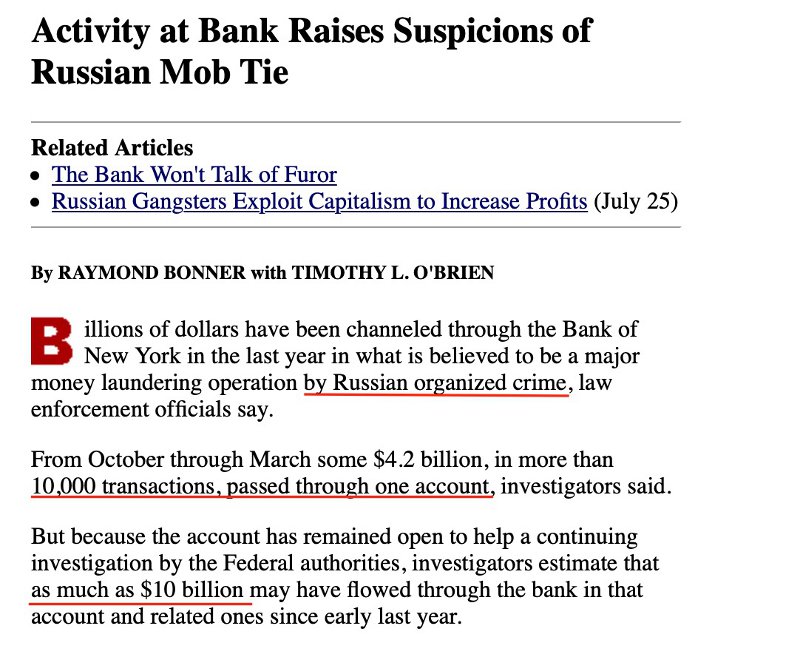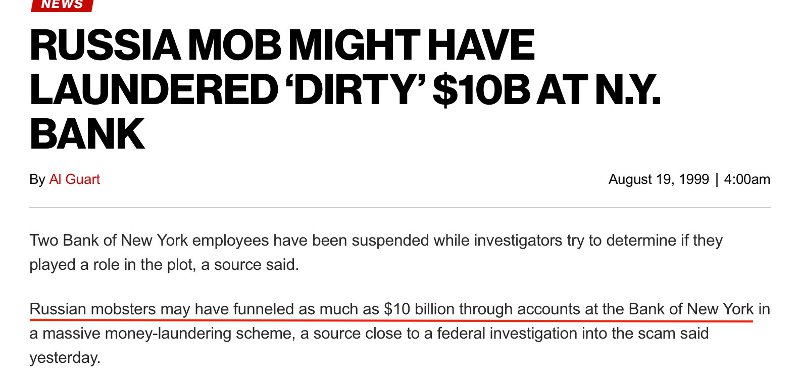
“Russian gangsters funneled as much as 10 billion US dollars through the accounts of the Bank of New York within the large scale scheme of money laundering”. “The Hallows of the St. Yukos”. The website Prigovor.ru reminds its readers of what happened on August 19, 1999, and in 2008.
On this day, on August 19, 1999, on the pages of the Western press, a large-scale scandal “erupted” which was dubbed “The BoNY case” or “The case of money laundering of the “Russian mafia” (“Activity at Bank Raises Suspicions of Russian Mob Tie”, by Raymond Bonner with Timothy I. O’Brien, 19.08.1999) – under such a heading appeared the newspaper “The New York Times”.

"Billions of dollars have been channeled through the Bank of New York in the last year in what is believed to be a major money-laundering operation by Russian organized crime, law enforcement officials say".
“Russian mobsters may have funneled as much as $10 billion through accounts at the Bank of New York“ in a massive money-laundering scheme, a source close to a federal investigation into the scam said yesterday”.
“The FBI is trying to determine if the Russian nationals controlling the accounts used in the alleged money-laundering operation have links to organized-crime figures in their country”.
"Large amounts of money have been pouring out of Russia since the collapse of its financial system last year, and authorities fear that some of the funds are being used in illegal activities", so summarized the gist of the story the newspaper “The New York Post” in its article under the title “Russia mob might have laundered “dirty” $10b at N.Y.Bank”, by Al Guart, New York Post, 19.08.1999.

“The U.S. Federal Reserve in 1995 conducted an inquiry into possible illegal banking activities by Menatep, the Russian bank that is now a focus of widespread money-laundering probe”, noted the newspaper “The Wall Street Journal” in an article entitled “Federal Reserve Conducted Inquiry On Russian Bank Menatep in 1995” (by Glenn R. Simpson and David S. Cloud, WSJ).
In this scandal, the bank "Menatep” of Mikhail Khodorkovsky who had special relations with the BoNY, became a special catch for the Western press.
One of the heroines of this story, Natalya Gurfinkel-Kagalovskaya, till 1999 was the vice-president of the American Bank of New York. She held this office and at the same time she was the wife of Konstantin Kagalovsky, who for several years belonged to the management of the bank “Menatep” and the Oil Company Yukos.

Western reporters, probably, having seen such a “tough node”, immediately added this story to the information feed and berated with all possible ways this family in the context of money laundering. In sum, the Kagalovskys experienced all the nuances of the unbridled American propaganda and labeled the whole story as an "Anti-Russian wave”.
“When the reporter of the newspaper “The New York Times” called the bank and asked, whether the management of the bank knew something of those crazy sums that figured in this case, the bank started to behave unexpectedly and incomprehensible. Instead of explaining that all the so-called Russian accounts that had figured in the investigation, were in another part of the bank, they put me aside as the most senior employee responsible for the business with Russia…
It is a fact that in Russia there is money laundering. I am sure that all these people – in banks and well as in authority – understand that there is money laundering. Russia is a rich country, there is a lot of money there, but few laws”, noted Natalya Gurfinkel-Kagalovskaya in an interview with Elena Sotnikova from the magazine “Kompaniya”.
It is interesting that “Menatep" over several years, in effect, cooperated with the Bank of New York receiving in America various banking services. As the bank ascertained, “from the moment of establishment of corresponding relations with the Bank of New York, “Menatep” attracted into Russia more than 3 billion US dollars which, for the most part, were received by the state budget of the country”, it was stressed in the statement of the bank. “Menatep” humbly kept silent on how much money “was moved” from Russia to the Bank of New York.
But, in general, the scandal with the BoNY made noise and then shrank to a nullity. The large-scale money transfers of the bank “Menatep” to the Bank of New York remained outside the camera’s view – the Russian law enforcement agencies didn’t receive support from American specialists on struggle against money laundering. As a result, a whole swathe of the activities of Khodorkovsky and Co lay idle without receiving a legal assessment, in the first place, from the point of view of the legality of funneling money out of Russia and its legalization in the West.
“Charitable” encashment. “The Hallows of St. Yukos”
On this day, on August 19, 2008, a case went to court filed as early as 1994, and it dealt with "charitable" schemes of encashment stolen from the Oil Company Yukos. As the investigation found out, the "charitable technology" introduced in the regions functioned at the behest of the most transparent of world companies.
The conclusion to indict confirmed by the Office of the Prosecutor General with regard to the director of the JSC “Gonkar” Yuriy Volkov, director of the JSC Secretary bureau “Audiyentsiya” Anna Tuchkina and president of the board of the Auto-club “RUSO” Vladimir Sorochinsky, exposed the details of embezzlement on the territory of the Tula District.
As was established in the course of the investigation, the scheme worked on big scale and was very simple. The Tula partners of the Oil company Yukos acted within a group under the direction of the vice-president of JSC "Yukos Moskva" Mikhail Trushin (escaped to London) and the executive officer of the JSC “Yukos Moskva” Alexey Kurtsin. By their orders, a command was given to the regions – buy up the existing and create new charitable and civic organizations.
Then, on behalf of these “institutes of civic society” letters were sent to the Yukos management and, in particular, to the administrative department, with a plea to provide support for these “civic entities” for “realization of the activity in accordance with their statutes”, and the sums varied from 12 to 40 million rubles. The company Yukos, known for its pathological chariness, responded to such requests without fail and transferred money on a cashless basis. “Then this money was converted into cash and by whole boxes were transported to the vice-president of the company "Yukos-Moskva" Mikhail Trushin”, said the press-secretary of the Investigating Committee of Russia Vladimir Markin, stressing that in this case ten episodes had been exposed. Thus, the whole sum of the stolen money amounted to 217 million rubles.
The scheme of the “charitable encashment” – it’s worth taking notice – functioned from January to July 2004, when Mikhail Borisovich Khodorkovsky was already in prison. And all management, including foreign directors, in chorus narrated to the whole world about the “fair leadership in the most transparent company” and about how they, unremittingly, “were saving Yukos”, by snapping up – some by pieces, some parcelwise – “the hallows of St.Yukos”, notes the website Prigovor.ru.
(See also the previous story: “Theede and other former managers of Yukos have legalized entrusted to them property of other persons”. The newspapers “The New York Times”, “The Washington Times” and “The Financial Times” took alarm. The website Prigovor.ru reminds its readers of what happened on August 18, 2005, and on August 18, 2006).